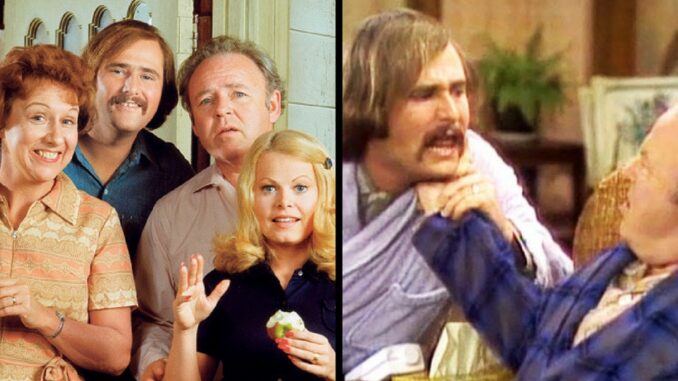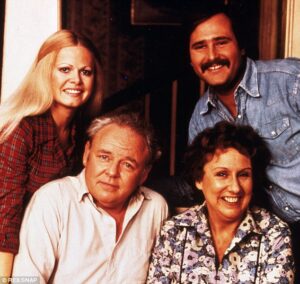
‘‘The program you are about to see is All in the Family. It seeks to throw a humorous spotlight on our frailties, prejudices, and concerns. By making them a source of laughter, we hope to show—in a mature fashion—just how absurd they are.’’
That was the disclaimer that CBS ran prior to the very first episode of All in the Family. The Norman Lear creation didn’t just push the envelope, it sealed and stamped it as well. But viewers kept tuning in week after week to see stories about previously taboo topics, such as menopause, rape, homosexuality, and race relations. Crack open a can of cling peaches (in heavy syrup) and enjoy this smelting pot of behind-the-scenes tidbits.
1. The Show Was Based On A British Sitcom.
Norman Lear bought the rights to Till Death Do Us Part in the late 1960s after reading about the BBC series, which ran for 10 years beginning in 1965, in Variety. Alf Garnett (Warren Mitchell) was a working-class conservative who lived in London’s East End with his wife, daughter, and liberal layabout Liverpudlian son-in-law. Alf had opinions on just about everything and was quite vocal in his dislike of Americans, Catholics, homosexuals, and anyone else who was “different” than him.
2. Archie Bunker Was Originally Archie Justice.
Lear thought that the BBC show’s set-up—a middle-aged, blue-collar conservative man who never hesitated to express his racist viewpoints, his doting wife, and his liberal daughter and son-in-law—could be mined for humor for American audiences. Justice for All, as the show was called in his original pilot script, starred Carroll O’Connor as Archie Justice and Jean Stapleton as his wife, Edith. Kelly Jean Peters and Tim McIntire rounded out the cast as Gloria and Richard (Meathead’s original name).
ABC passed on the show, however; Their main complaint being Archie and Edith’s lack of chemistry with the younger actors. Lear recast the roles with Candy Azzara and Chip Oliver, changed the name of the show to Those Was the Days and shot a new pilot, but ABC was still uninterested.

3. CBS’s Robert Wood Helped the Show to Get on the Air.
It was Robert Wood who helped the show get on the air. According to the market research, a younger demographic loved more socially-related and more cutting-edge shows. It was considered as relevant enough as a replacement series.
4. The Future Wife of Rob Reiner, Penny Marshall, Almost Landed in the Role of Mrs. Stivic.
The future wife of Rob Reiner named Penny Marshall almost landed in the role of Mrs. Stivic. She was summoned the role to do improve and read lines with Reiner. But, Struthers had been chosen.
5. The Porches Did Not Match the Exterior of the Home in Queens.
In considering the porch scenes and in looking closely at the exterior of the home in Queens, the porches did not match. The series emphasizes that the porch had held several people. But before the original exterior filmed, it could not.
6. All in the Family was the Most Important Television Series of All Time.
The series became the most important of all hardships as well as for women. The public affairs are brought to light in a thought-provoking and comical way. It emphasizes crazed situations, brash views, filmmaking techniques and envelope-pushing elements.
7. The Show Received a Lot of Mail and Calls About the Theme Song.
Before the first two seasons, many asked have and called to ask about the last line of the opening theme story. They had trouble understanding “Gee; our old LaSalle ran great.” It was then that the song was recorded in season 3.
8. The Debate on Sock and Shoe was Based on a Real-Life Incident.
The habit of Reiner of putting a sock and shoe on one foot before dressing the other one is based on a real-life story. Reiner just related it to the writers, and it was included in the scene.
9.The Show Also Featured a Complete Frontal Male Nudity.
The show also featured frontal male nudity with a 3-week old baby named Joey Stivic. The show shattered a taboo in the year of 1976. The nudity was also germane and filmed to the plot. In that same year, an official doll which was physically correct was released.
10. Carroll O’ Connor Did Write the Lyrics before the Closing Theme Song.
It was Carroll O’ Connor who initiated his lyrics. He received credit for being a co-writer. He approached Kellaway to share something that would make the instrumental better and more impressive.
11. Four of the Episodes were Taped When on a Salary Dispute.
There were salary disputes concerning O’Connor protesting over his working conditions and wages. The three episodes were filmed starting with “Where is Archie?” He claimed that the production owed him 64,000 dollars in back pay.
12. The Viewer Backlash Did Not Actually Materialize.
Extra operators had been hired to handle the onset of outraged telephone calls. Only a few viewers were offended. Americans embraced Archie Bunker. Campaign buttons and bumper stickers were all around.
